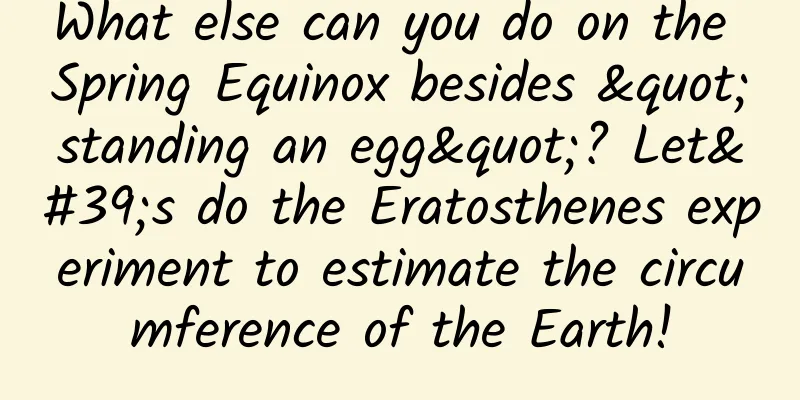What else can you do on the Spring Equinox besides "standing an egg"? Let's do the Eratosthenes experiment to estimate the circumference of the Earth!

|
Open any modern introductory science book or search the Internet, and we can easily find the precise data of the diameter and circumference of the earth: the average diameter is about 12,742 kilometers, and the equatorial circumference is about 40,076 kilometers, which are measured using advanced tools such as artificial satellites. So how did people know the circumference of the earth in ancient times when technology was not well developed? The earliest human measurement of the diameter and circumference of the earth was more than 200 years BC, during the time of China's Qin Shihuang. At that time, the ancient Greek mathematician, geographer, astronomer, and the famous director of the Library of Alexandria in Egypt, Eratosthenes (280-190 BC), used a clever measurement method to roughly measure the size of the earth. It is said that at that time, there was a very deep vertical well in Syene (roughly equivalent to the Aswan area in southern Egypt today), which was almost at the same longitude as Alexandria, south of Alexandria. At noon on the summer solstice (June 21 or 22 every year, when the sun shines directly on the Tropic of Cancer), the sunlight could shine all the way to the bottom of the well. That is to say, at that place, the sun is at the zenith at noon on the summer solstice, and its angle of incidence is 0 degrees. However, in Alexandria, located on the Mediterranean coast of the Nile Delta in northern Egypt, the sun cannot directly hit the ground at noon on the summer solstice, so Eratosthenes used a tall tower (such as an obelisk) to measure the angle of the sun's radiation by measuring the length of the shadow. Using simple geometry, he measured the angle of incidence of sunlight to be 7.2 degrees. If we accept the view that the earth is spherical (this has been generally confirmed by scientists before, using evidence such as the shape of the edge of the moon obscured during a lunar eclipse), then the difference of 7.2 degrees should be the ground arc distance between Alexandria and Seyni (as shown in the figure), which is roughly equivalent to 1/50 of a 360-degree circle. He asked the camel caravan merchants traveling between the two places and got the approximate time required for the trip. According to the average speed of camels, he roughly estimated that the distance between the two places was about 5,000 "Stadia" (Stadia, the unit of length at the time, roughly equivalent to 155 meters according to the Greek system). From this, he calculated that the circumference of the earth is about 5,000✕50=250,000 Stadia, which is about 39,000 kilometers, which is really not much different from the precise value of modern measurements! This is the famous Eratosthenes Experiment. Of course, if we want to conduct similar experiments to measure the circumference of the Earth, we don’t have to find a special place like Seine (which is located on the Tropic of Cancer, so the sun shines directly at noon on the summer solstice), nor do we have to wait until the summer solstice. Every year, the "Eratosthenes Experiment" joint measurement activity (official activity website: http://eratosthenes.ea.gr) is organized on the day of the spring equinox (this year it is March 20-21). By measuring and comparing the length of the local noon shadow on the spring equinox at different locations at the same longitude, the circumference of the earth can even be calculated by comparing the measured value of a single location with the observation point on the virtual equator at the same longitude. The activity calls on schools around the world to actively register and participate, measure and report data. At the same time, you can take wonderful photos of your experiments and participate in the photo contest (Photo Contest)~ The measurement method is relatively simple. Through geometric trigonometry knowledge, the shadow length is used to measure the solar incident angle θ (θ = arctan (shadow length / rod length)), and compared with the incident angle of another location at the same longitude, the arc distance Δθ between the two locations is calculated. Use an online map (such as Baidu Map) to roughly measure the distance d between the two locations. Then: The circumference of the earth ≈ the distance between two places d ✕ 360° / the arc distance between two places Δθ --- Formula 1. If you cannot find another observation point with a similar longitude to yours (if the longitudes of the two places are not exactly the same, you can translate the other observation point with the same latitude to your longitude and then measure the distance), you can also compare with a virtual observation point in the equatorial region (with the same longitude): Since the sun shines directly on the equator on the vernal equinox (the solar incidence angle at noon in the equator is 0), the arc distance between you and the equatorial point with the same longitude is the solar incidence angle θ measured at your place, and the distance d between the two places can be measured using the online map. Then: The circumference of the earth ≈ the distance between two places d ✕ 360° / the solar incidence angle θ --- Formula 2. Note: Formula 1 is valid for all measurement dates (not necessarily the vernal equinox), while Formula 2 is valid only for the vernal equinox. Also note that the measurement time is local noon at the observation location, not the local time (such as Beijing time) that is normally used at the location, so a simple conversion is required. You can measure several times around noon, and substitute the value of the shortest shadow length into the calculation (think about why?), or use Stellarium software to simulate (when the sun is 180 degrees south). Are you excited? In addition to playing the "standing egg" game on the Spring Equinox, please do the Eratosthenes experiment together! You can leave us your measurement results and rough estimates of the Earth's circumference in the comments~ Editing and review: Teacher Yuancai Weihai Astronomical Observatory of Shandong University (also Weihai Astronomical Observatory) Institute of Space Science, Shandong University Shandong Astronomical Society 2022.3.20 |
Recommend
ViewController has many good transition animations
Source code introduction Cool transition animatio...
Core Consulting: Light Commercial Vehicle Market Forecast Research Report in August 2023
1. Industry Insights Foton Auman AMT product upgr...
Taobao's magic tool turns iPhone into dual SIM dual standby, and the actual test is shocking
Everyone knows that the iPhone has no dual SIM ca...
Huawei Qiankun Intelligent Driving helps the city and the wild, smart and brave hardcore SUV Fangcheng Baobao 8 to be launched
On November 12, BYD and Huawei jointly launched t...
Apple's toothpaste squeeze is causing trouble! iPhone 7 sales are going to plummet: Chinese users don't like it
Not long after iPhone 7 was launched on the marke...
From Weibo to Toutiao to Zhihu, where are the three content giants going?
Weibo's market value today has reached 10 bil...
Musk: A new generation of flying Roadster sports car will be launched in 2020
Tesla CEO Elon Musk has made many surprising stat...
Xueersi’s promotion case study on the activity of bringing up new employees
Xueersi is one of the twin stars in the education...
What is the user value of the automotive aftermarket? Analyzing the definition of the automotive aftermarket
The automotive aftermarket is a service-oriented ...
Baozige OBS + partner gameplay + quick tagging + fish farming
Baozige OBS + partner gameplay + quick tagging + ...
Xinri Hengli explains the cross-border acquisition of Aerospace Automobile to enter the field of new energy vehicle production
After several failed attempts at cross-border acq...
Growth hacking in action
The Internet is the most disruptive engine in mod...
What are the media search tools commonly used by new media operation experts?
I once naively thought Search for resources onlin...
Why can the induction cooker heat up the hot pot, but people’s hands don’t get hot when they put them on it?
When you go to a hotpot restaurant to eat hotpot,...
Public account disk says "Swordsman" teaching video
Public account Panmian said "Swordsman"...









